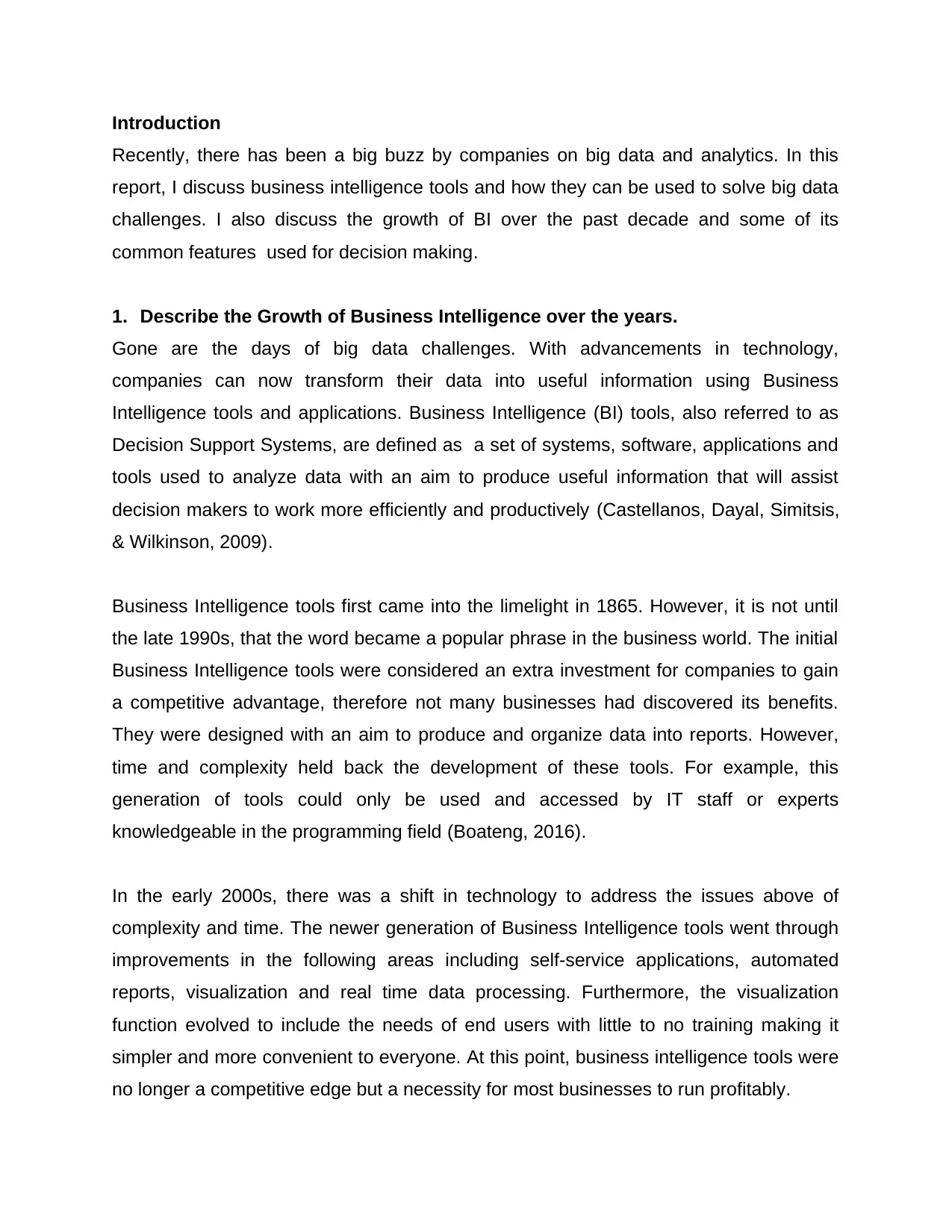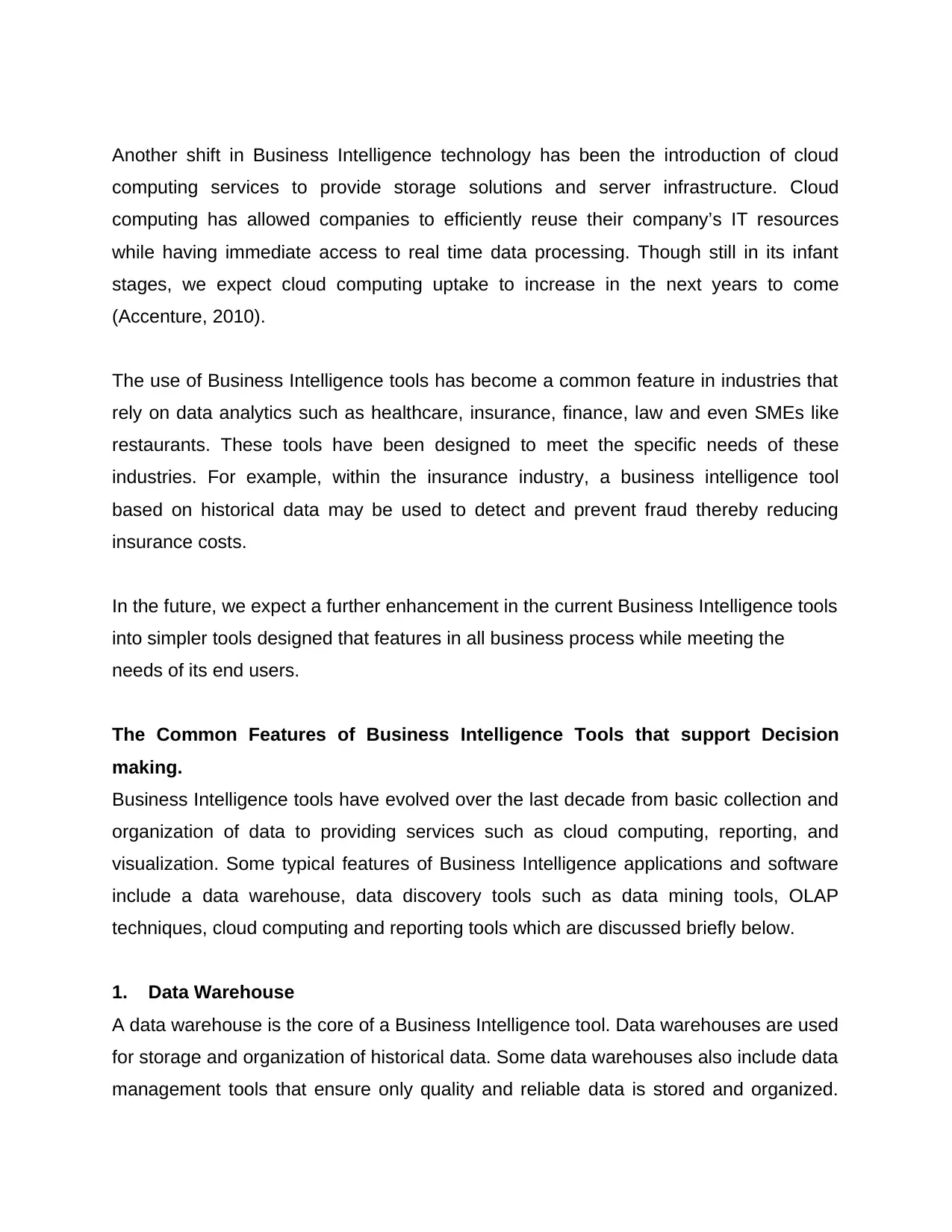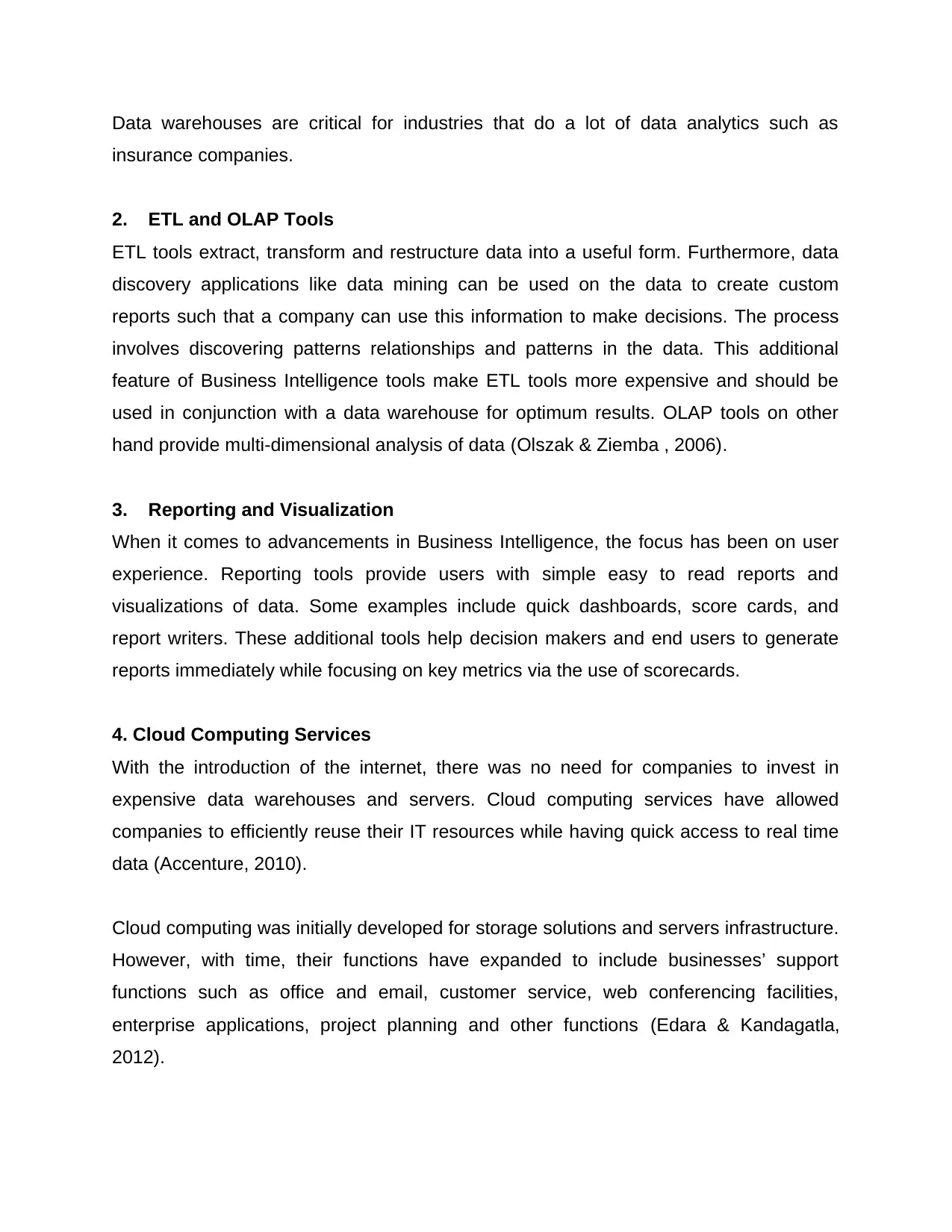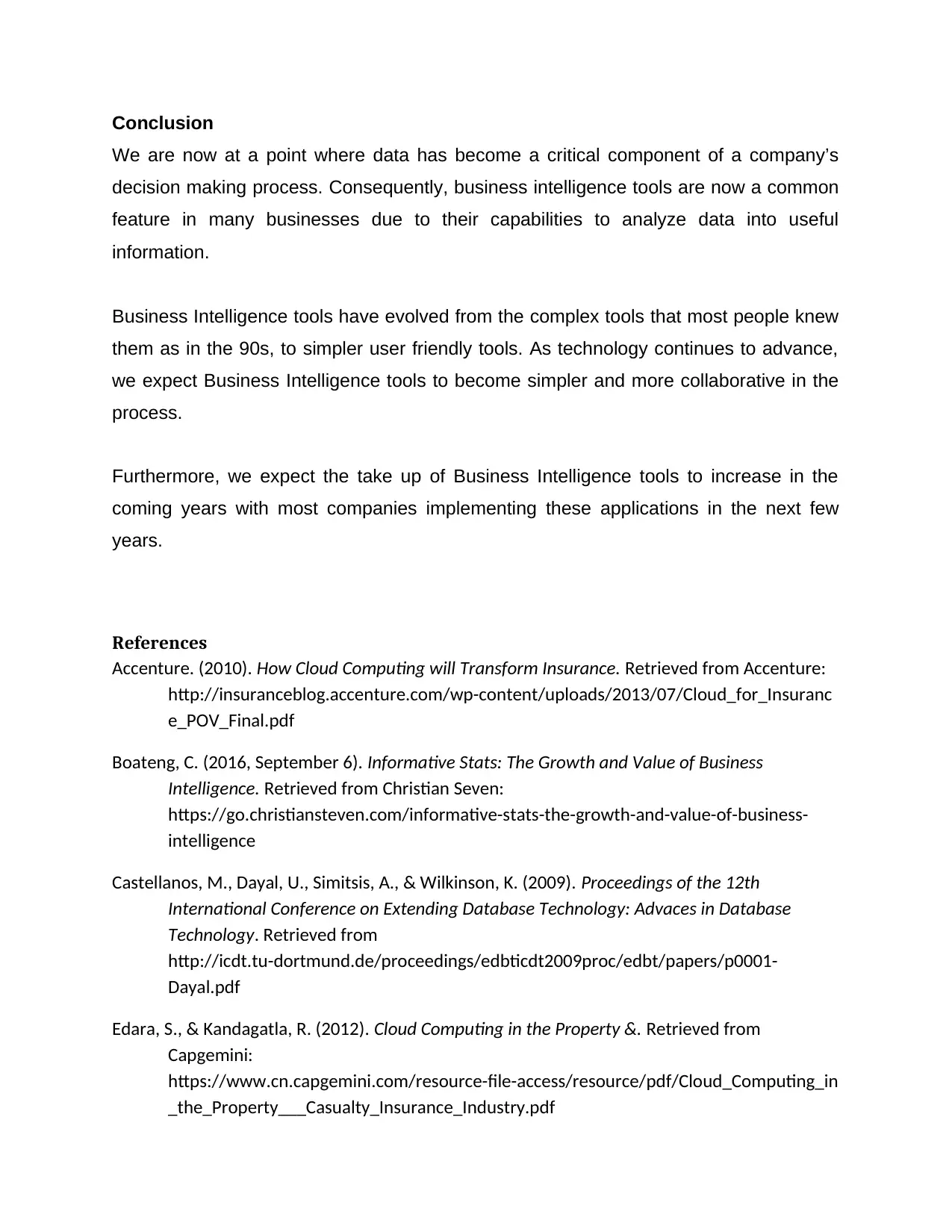Business Intelligence Tools: Growth, Features, and Decision-Making
VerifiedAdded on 2020/02/24
|5
|1268
|97
Report
AI Summary
This report provides a comprehensive overview of business intelligence (BI) tools, exploring their evolution and impact on data-driven decision-making. It begins by tracing the growth of BI from its early stages to its current prevalence, highlighting how technological advancements have enabled companies to transform data into actionable insights. The report then delves into the common features of BI tools, including data warehouses, ETL and OLAP tools, reporting and visualization capabilities, and cloud computing services. Each feature is explained in detail, emphasizing its role in supporting decision-making processes across various industries, such as insurance, finance, and healthcare. The report concludes by emphasizing the increasing importance of BI tools in today's business environment, predicting further advancements and wider adoption in the years to come.

Introduction
Recently, there has been a big buzz by companies on big data and analytics. In this
report, I discuss business intelligence tools and how they can be used to solve big data
challenges. I also discuss the growth of BI over the past decade and some of its
common features used for decision making.
1. Describe the Growth of Business Intelligence over the years.
Gone are the days of big data challenges. With advancements in technology,
companies can now transform their data into useful information using Business
Intelligence tools and applications. Business Intelligence (BI) tools, also referred to as
Decision Support Systems, are defined as a set of systems, software, applications and
tools used to analyze data with an aim to produce useful information that will assist
decision makers to work more efficiently and productively (Castellanos, Dayal, Simitsis,
& Wilkinson, 2009).
Business Intelligence tools first came into the limelight in 1865. However, it is not until
the late 1990s, that the word became a popular phrase in the business world. The initial
Business Intelligence tools were considered an extra investment for companies to gain
a competitive advantage, therefore not many businesses had discovered its benefits.
They were designed with an aim to produce and organize data into reports. However,
time and complexity held back the development of these tools. For example, this
generation of tools could only be used and accessed by IT staff or experts
knowledgeable in the programming field (Boateng, 2016).
In the early 2000s, there was a shift in technology to address the issues above of
complexity and time. The newer generation of Business Intelligence tools went through
improvements in the following areas including self-service applications, automated
reports, visualization and real time data processing. Furthermore, the visualization
function evolved to include the needs of end users with little to no training making it
simpler and more convenient to everyone. At this point, business intelligence tools were
no longer a competitive edge but a necessity for most businesses to run profitably.
Recently, there has been a big buzz by companies on big data and analytics. In this
report, I discuss business intelligence tools and how they can be used to solve big data
challenges. I also discuss the growth of BI over the past decade and some of its
common features used for decision making.
1. Describe the Growth of Business Intelligence over the years.
Gone are the days of big data challenges. With advancements in technology,
companies can now transform their data into useful information using Business
Intelligence tools and applications. Business Intelligence (BI) tools, also referred to as
Decision Support Systems, are defined as a set of systems, software, applications and
tools used to analyze data with an aim to produce useful information that will assist
decision makers to work more efficiently and productively (Castellanos, Dayal, Simitsis,
& Wilkinson, 2009).
Business Intelligence tools first came into the limelight in 1865. However, it is not until
the late 1990s, that the word became a popular phrase in the business world. The initial
Business Intelligence tools were considered an extra investment for companies to gain
a competitive advantage, therefore not many businesses had discovered its benefits.
They were designed with an aim to produce and organize data into reports. However,
time and complexity held back the development of these tools. For example, this
generation of tools could only be used and accessed by IT staff or experts
knowledgeable in the programming field (Boateng, 2016).
In the early 2000s, there was a shift in technology to address the issues above of
complexity and time. The newer generation of Business Intelligence tools went through
improvements in the following areas including self-service applications, automated
reports, visualization and real time data processing. Furthermore, the visualization
function evolved to include the needs of end users with little to no training making it
simpler and more convenient to everyone. At this point, business intelligence tools were
no longer a competitive edge but a necessity for most businesses to run profitably.
Paraphrase This Document
Need a fresh take? Get an instant paraphrase of this document with our AI Paraphraser

Another shift in Business Intelligence technology has been the introduction of cloud
computing services to provide storage solutions and server infrastructure. Cloud
computing has allowed companies to efficiently reuse their company’s IT resources
while having immediate access to real time data processing. Though still in its infant
stages, we expect cloud computing uptake to increase in the next years to come
(Accenture, 2010).
The use of Business Intelligence tools has become a common feature in industries that
rely on data analytics such as healthcare, insurance, finance, law and even SMEs like
restaurants. These tools have been designed to meet the specific needs of these
industries. For example, within the insurance industry, a business intelligence tool
based on historical data may be used to detect and prevent fraud thereby reducing
insurance costs.
In the future, we expect a further enhancement in the current Business Intelligence tools
into simpler tools designed that features in all business process while meeting the
needs of its end users.
The Common Features of Business Intelligence Tools that support Decision
making.
Business Intelligence tools have evolved over the last decade from basic collection and
organization of data to providing services such as cloud computing, reporting, and
visualization. Some typical features of Business Intelligence applications and software
include a data warehouse, data discovery tools such as data mining tools, OLAP
techniques, cloud computing and reporting tools which are discussed briefly below.
1. Data Warehouse
A data warehouse is the core of a Business Intelligence tool. Data warehouses are used
for storage and organization of historical data. Some data warehouses also include data
management tools that ensure only quality and reliable data is stored and organized.
computing services to provide storage solutions and server infrastructure. Cloud
computing has allowed companies to efficiently reuse their company’s IT resources
while having immediate access to real time data processing. Though still in its infant
stages, we expect cloud computing uptake to increase in the next years to come
(Accenture, 2010).
The use of Business Intelligence tools has become a common feature in industries that
rely on data analytics such as healthcare, insurance, finance, law and even SMEs like
restaurants. These tools have been designed to meet the specific needs of these
industries. For example, within the insurance industry, a business intelligence tool
based on historical data may be used to detect and prevent fraud thereby reducing
insurance costs.
In the future, we expect a further enhancement in the current Business Intelligence tools
into simpler tools designed that features in all business process while meeting the
needs of its end users.
The Common Features of Business Intelligence Tools that support Decision
making.
Business Intelligence tools have evolved over the last decade from basic collection and
organization of data to providing services such as cloud computing, reporting, and
visualization. Some typical features of Business Intelligence applications and software
include a data warehouse, data discovery tools such as data mining tools, OLAP
techniques, cloud computing and reporting tools which are discussed briefly below.
1. Data Warehouse
A data warehouse is the core of a Business Intelligence tool. Data warehouses are used
for storage and organization of historical data. Some data warehouses also include data
management tools that ensure only quality and reliable data is stored and organized.

Data warehouses are critical for industries that do a lot of data analytics such as
insurance companies.
2. ETL and OLAP Tools
ETL tools extract, transform and restructure data into a useful form. Furthermore, data
discovery applications like data mining can be used on the data to create custom
reports such that a company can use this information to make decisions. The process
involves discovering patterns relationships and patterns in the data. This additional
feature of Business Intelligence tools make ETL tools more expensive and should be
used in conjunction with a data warehouse for optimum results. OLAP tools on other
hand provide multi-dimensional analysis of data (Olszak & Ziemba , 2006).
3. Reporting and Visualization
When it comes to advancements in Business Intelligence, the focus has been on user
experience. Reporting tools provide users with simple easy to read reports and
visualizations of data. Some examples include quick dashboards, score cards, and
report writers. These additional tools help decision makers and end users to generate
reports immediately while focusing on key metrics via the use of scorecards.
4. Cloud Computing Services
With the introduction of the internet, there was no need for companies to invest in
expensive data warehouses and servers. Cloud computing services have allowed
companies to efficiently reuse their IT resources while having quick access to real time
data (Accenture, 2010).
Cloud computing was initially developed for storage solutions and servers infrastructure.
However, with time, their functions have expanded to include businesses’ support
functions such as office and email, customer service, web conferencing facilities,
enterprise applications, project planning and other functions (Edara & Kandagatla,
2012).
insurance companies.
2. ETL and OLAP Tools
ETL tools extract, transform and restructure data into a useful form. Furthermore, data
discovery applications like data mining can be used on the data to create custom
reports such that a company can use this information to make decisions. The process
involves discovering patterns relationships and patterns in the data. This additional
feature of Business Intelligence tools make ETL tools more expensive and should be
used in conjunction with a data warehouse for optimum results. OLAP tools on other
hand provide multi-dimensional analysis of data (Olszak & Ziemba , 2006).
3. Reporting and Visualization
When it comes to advancements in Business Intelligence, the focus has been on user
experience. Reporting tools provide users with simple easy to read reports and
visualizations of data. Some examples include quick dashboards, score cards, and
report writers. These additional tools help decision makers and end users to generate
reports immediately while focusing on key metrics via the use of scorecards.
4. Cloud Computing Services
With the introduction of the internet, there was no need for companies to invest in
expensive data warehouses and servers. Cloud computing services have allowed
companies to efficiently reuse their IT resources while having quick access to real time
data (Accenture, 2010).
Cloud computing was initially developed for storage solutions and servers infrastructure.
However, with time, their functions have expanded to include businesses’ support
functions such as office and email, customer service, web conferencing facilities,
enterprise applications, project planning and other functions (Edara & Kandagatla,
2012).
⊘ This is a preview!⊘
Do you want full access?
Subscribe today to unlock all pages.

Trusted by 1+ million students worldwide

Conclusion
We are now at a point where data has become a critical component of a company’s
decision making process. Consequently, business intelligence tools are now a common
feature in many businesses due to their capabilities to analyze data into useful
information.
Business Intelligence tools have evolved from the complex tools that most people knew
them as in the 90s, to simpler user friendly tools. As technology continues to advance,
we expect Business Intelligence tools to become simpler and more collaborative in the
process.
Furthermore, we expect the take up of Business Intelligence tools to increase in the
coming years with most companies implementing these applications in the next few
years.
References
Accenture. (2010). How Cloud Computing will Transform Insurance. Retrieved from Accenture:
http://insuranceblog.accenture.com/wp-content/uploads/2013/07/Cloud_for_Insuranc
e_POV_Final.pdf
Boateng, C. (2016, September 6). Informative Stats: The Growth and Value of Business
Intelligence. Retrieved from Christian Seven:
https://go.christiansteven.com/informative-stats-the-growth-and-value-of-business-
intelligence
Castellanos, M., Dayal, U., Simitsis, A., & Wilkinson, K. (2009). Proceedings of the 12th
International Conference on Extending Database Technology: Advaces in Database
Technology. Retrieved from
http://icdt.tu-dortmund.de/proceedings/edbticdt2009proc/edbt/papers/p0001-
Dayal.pdf
Edara, S., & Kandagatla, R. (2012). Cloud Computing in the Property &. Retrieved from
Capgemini:
https://www.cn.capgemini.com/resource-file-access/resource/pdf/Cloud_Computing_in
_the_Property___Casualty_Insurance_Industry.pdf
We are now at a point where data has become a critical component of a company’s
decision making process. Consequently, business intelligence tools are now a common
feature in many businesses due to their capabilities to analyze data into useful
information.
Business Intelligence tools have evolved from the complex tools that most people knew
them as in the 90s, to simpler user friendly tools. As technology continues to advance,
we expect Business Intelligence tools to become simpler and more collaborative in the
process.
Furthermore, we expect the take up of Business Intelligence tools to increase in the
coming years with most companies implementing these applications in the next few
years.
References
Accenture. (2010). How Cloud Computing will Transform Insurance. Retrieved from Accenture:
http://insuranceblog.accenture.com/wp-content/uploads/2013/07/Cloud_for_Insuranc
e_POV_Final.pdf
Boateng, C. (2016, September 6). Informative Stats: The Growth and Value of Business
Intelligence. Retrieved from Christian Seven:
https://go.christiansteven.com/informative-stats-the-growth-and-value-of-business-
intelligence
Castellanos, M., Dayal, U., Simitsis, A., & Wilkinson, K. (2009). Proceedings of the 12th
International Conference on Extending Database Technology: Advaces in Database
Technology. Retrieved from
http://icdt.tu-dortmund.de/proceedings/edbticdt2009proc/edbt/papers/p0001-
Dayal.pdf
Edara, S., & Kandagatla, R. (2012). Cloud Computing in the Property &. Retrieved from
Capgemini:
https://www.cn.capgemini.com/resource-file-access/resource/pdf/Cloud_Computing_in
_the_Property___Casualty_Insurance_Industry.pdf
Paraphrase This Document
Need a fresh take? Get an instant paraphrase of this document with our AI Paraphraser

Olszak, C. M., & Ziemba , E. (2006). Business intelligence systems in the holistic infrastructure
development supporting decision-making in organizations. nterdisciplinary Journal of
Information, Knowledge and Management, 47-58.
development supporting decision-making in organizations. nterdisciplinary Journal of
Information, Knowledge and Management, 47-58.
1 out of 5
Related Documents
Your All-in-One AI-Powered Toolkit for Academic Success.
+13062052269
info@desklib.com
Available 24*7 on WhatsApp / Email
![[object Object]](/_next/static/media/star-bottom.7253800d.svg)
Unlock your academic potential
Copyright © 2020–2025 A2Z Services. All Rights Reserved. Developed and managed by ZUCOL.





